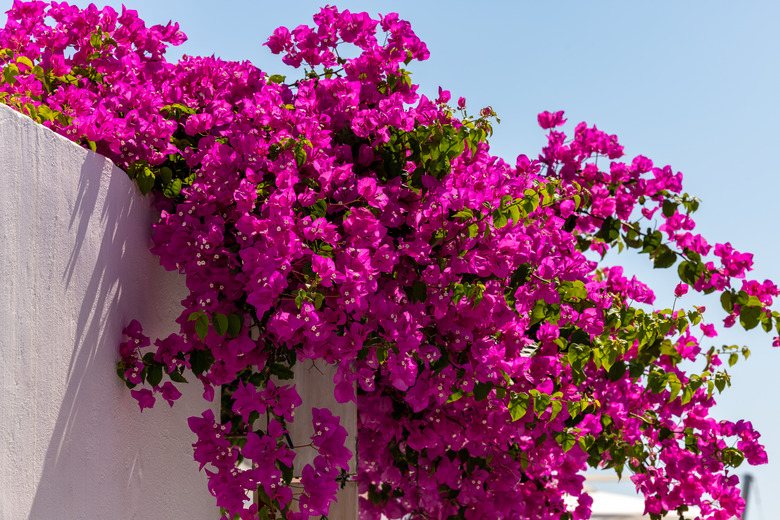How To Cure Yellow Leaves On Bougainvillea
We may receive a commission on purchases made from links.
Bougainvillea (Bougainvillea spp.) is generally an easy-care vine, flowering profusely and growing quickly to cover an arbor or trellis. If your bougainvillea leaves are turning yellow, the most likely culprits are either watering issues or a lack of micronutrients in the soil.
Too Much or Too Little Water
Too Much or Too Little Water
Yellowing leaves on a bougainvillea can mean water stress, either too much or too little, although the former is the most common since these vines love heat. If the weather is very hot and dry and the vines are young, they may be crying out for more water. Using your finger, dig into the soil around your plant to see if it is bone dry. If so, water it thoroughly and then let it dry before further watering.
If the soil is instead damp or even wet, you have been overwatering or nature has been overwatering for you. In this case, the vine's roots may be waterlogged and may have even developed a fungal rot infection. Stop watering completely and see if the plant recovers. If the leaves continue to yellow and even fall off, the best course of action is to remove the plant and replace it with a new, healthy vine in a garden location with better drainage.
Lack of Micronutrients
Lack of Micronutrients
Any tree, shrub, or vine can develop chlorosis, which is a lack of chlorophyll due to an imbalance of micronutrients in the soil. Bougainvillea, while not a heavy feeder in regard to fertilizer, can still be susceptible to chlorosis, which results in the bougainvillea leaves turning yellow, although the leaf veins themselves remain green. If severe, the leaves may turn brown, die, and fall off.
To address the problem, you'll need a soil test so you can provide the proper nutrients. Gather some soil around the vine and get it professionally tested for micronutrients and pH. If the results point to a lack of iron — one of the most common causes of chlorosis — feed the vine with chelated iron compounds. If high pH is the problem, lower the pH using sulfur or ammonium sulfate.
Tips for Growing Healthy Bougainvillea
Tips for Growing Healthy Bougainvillea
Bougainvillea is a tropical and subtropical vine, so first and foremost, make sure your area is in a USDA zone in which it can grow, which is no colder than zone 9 if it has protection, although zone 10 and up are recommended. Weather that is too cold can kill the vine, and yellowing leaves will be the first symptom. The leaves will then drop off, and the plant will not produce new growth, becoming bare.
To avoid root or stem rot, choose a full-sun location with well-drained soil and a pH of just over 6.0. Fertilize your vine twice a year. Avoid standard, balanced fertilizers and use a formula specially designed for bougainvillea or hibiscus.
Prune suckers off the base to encourage more growth at the top and remove dead wood. If you need to manage the overall shape, perform more extensive pruning after summer in the late fall or spring.
